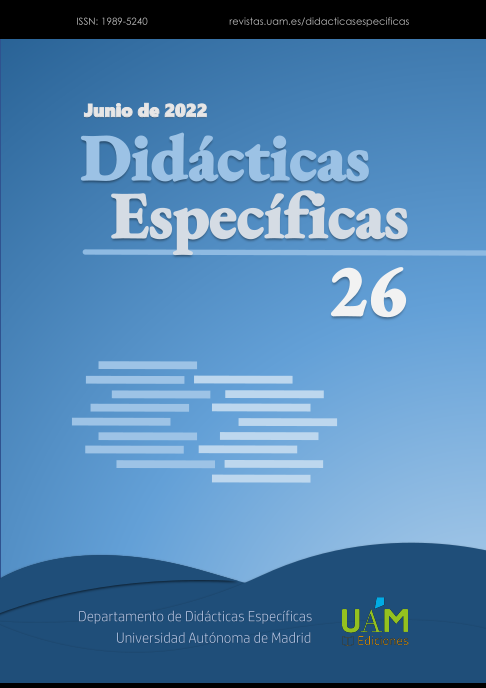Knowledge on insects in early childhood education: diagnostic evaluation and improvement of their perception
DOI:
https://doi.org/10.15366/didacticas2022.26.004Keywords:
Natural environment teaching, Environmental education, Childhood education, InsectsAbstract
Insects represent a broad, fundamental and close part of biodiversity. However, the knowledge of early childhood education students on insects may be lower than about vertebrate animals, and their perceptions more negative. The width of the insect concept, and insect knowledge in urban students of early childhood education is analysed. A didactic sequence was implemented with the aim to improve insects knowledge, and change anthropomorphic insect versions to real insects in their minds. Activities include modelling clay, memory games, videos, childhood education common activities modified including insects, and search for arthropods in the schoolyard. The sequence implemented has allowed both increasing knowledge and fostering curiosity and respect for insects among students.
Downloads
References
ATKINSON, K. (2015): Wasps-Bees-Mushrooms-Children: Reimagining Multispecies Relations in Early Childhood Pedagogies. Canadian Children, Journal of the Canadian Association for Young Children, 40, 67-79. https://doi.org/10.18357/jcs.v40i2.15180
BOILEAU, Y. S. & RUSELL, C. (2018): Insect y Human Flourishing in Early Childhood Education: Learning and Crawling Together. En A. Cutter-Mackenzie, K. Malone, y E. Barratt Hacking (Eds.), International handbook on childhood nature: Assemblages of childhood and nature. New York, NY: Springer. https://doi.org/10.1007/978-3-319-51949-4_65-1
BREUER, G.B., SCHLEGEL, J. & RUPF, R. (2015): Selecting insects as flagship species for Beverin nature park in Switzerland: a survey of local school children on their attitudes towards butterflies and other insects. eco.mont-Journal on Protected Mountain Areas Research and Management, 7, 5-16.
DÍEZ, J., MEÑIKA, A., SANZ-AZKUE, I. & ORTUZAR, A. (2018): Urban and Rural Children’s Knowledge on Biodiversity in Bizkaia: Tree Identification Skills and Animal and Plant Listing. International Journal of Humanities and Social Sciences, 12, 396-400. https://doi.org/10.5281/zenodo.1316197
DRISSNER, J., KRIMM, H. & HILLE, K. (2017): Attitudes of School Children in Germany, Costa Rica and Ukraine Towards Invertebrates - A Comparison. International Journal of Modern Education Research, 4(2), 6-9. http://www.aascit.org/journal/archive2?journalId=910&paperId=5235
EDWARDS, S., MOORE, D. & CUTTER-MACKENZIE, A. (2012): Beyond "killing, screaming and being scared of insects": Learning and teaching about biodiversity in early childhood education. Early Childhood Folio, 16(2), 12-19.
FISHER-MALTESE, C. & ZIMMERMAN, T. D. (2015): A Garden-Based Approach to Teaching Life Science Produces Shifts in Students' Attitudes toward the Environment. International Journal of Environmental and Science Education, 10(1), 51-66. http://www.ijese.net/makale/147.html
GÁLVEZ ESTEBAN, R. (2021): ¿Quién es quién? Directrices de uso de una clave dicotómica para la identificación de artrópodos en Educación Primaria. Didácticas Específicas, 24, 75-89. https://doi.org/10.15366/didacticas2021.24.005
GÓMEZ PRADO, B., PUIG, B. & EVAGOROU, M. (2020): Primary pre-service teachers’ emotions and interest towards insects: an explorative case study. Journal of Biological Education, https://doi.org/10.1080/00219266.2020.1756896
HOSAKA, T., SUGIMOTO, K. & NUMATA, S. (2017): Childhood experience of nature influences the willingness to coexist with biodiversity in cities. Palgrave Communications, 3, 17071. https://doi.org/10.1057/palcomms.2017.71
LEANDRO, C. & JAY-ROBERT, P. (2019): Perceptions and representations of animal diversity: Where did the insects go? Biological Conservation, 237, 400-408. https://doi.org/10.1016/j.biocon.2019.07.031
LEMELIN, R. H., DAMPIER, J., HARPER, R., BOWLES, R. & BALIKA, D. (2017): Perceptions of Insects. A visual analysis, Society & Animals, 25(6), 553-572. https://doi.org/10.1163/15685306-12341469
LINDEMANN?MATTHIES, P. (2005): ‘Loveable’ mammals and ‘lifeless’ plants: how children's interest in common local organisms can be enhanced through observation of nature. International journal of science education, 27(6), 655-677. https://doi.org/10.1080/09500690500038116
MATTHEWS, R. W., FLAGE, AND, L. R. & MATTHEWS, J. R. (1997): Insects as teaching tools in primary and secondary education. Annual Review of Entomology, 42(1), 269-289. https://doi.org/10.1146/annurev.ento.42.1.269
MESSNER, K. & SILAS NEAL, C. (2018): Arriba en el huerto y abajo en la tierra. Editorial Colombo.
MIGUÉLEZ, M., ANSEDES, B., VIDAL, M. & MEMBIELA, P. (2017): Un proyecto centrado en los insectos palo. Aula de Infantil, 90, 35-38. https://www.grao.com/es/producto/un-proyecto-centrado-en-los-insectos-palo
PINILLAS FERNÁNDEZ, S. & TORRALBA-BURRIAL, A. (2021): El cuaderno de campo como eje del aprendizaje de naturaleza cercana en Educación Infantil. Revista Eureka sobre Enseñanza y Divulgación de las Ciencias, 18(3), 3202. https://doi.org/10.25267/Rev_Eureka_ensen_divulg_cienc.2021.v18.i3.3202
PIZARRO-ARAYA, J., LÓPEZ-CORTÉS, F., JEWELL, S. M. & INOSTROZA, M. C. (2014): Preferencias de niños y niñas en relación con los artrópodos epigeos (Metazoa: Arthropoda) del desierto florido de Chile. Idesia (Arica), 32(3), 13-23. http://dx.doi.org/10.4067/S0718-34292014000300003
SEGURA, A. M. & TORRALBA-BURRIAL, A. (2019): Conceptos e infraestructuras didácticas en los procesos de enseñanza-aprendizaje de la biodiversidad en Educación Infantil: análisis de la situación en Asturias. Universitas Tarraconensis. Revista de Ciències de l'Educació, 2019.2, 43-60. https://doi.org/10.17345/ute.2019.2.2653
SHEPARDSON, D.P. (2002): Bugs, butterflies, and spiders: children’s understandings about insect. International Journal of Science Education, 24(6), 627-643. https://doi.org/10.1080/09500690110074765
SNADDON J. L. & TURNER, E. C. (2007): A child's eye view of the insect world: Perceptions of insect diversity. Environmental Conservation, 34(1), 33-35. https://doi.org/10.1017/S0376892907003669
SNADDON, J.L., TURNER, E.C. & FOSTER, W.A. (2008): Children’s perceptions of rainforest biodiversity: which animals have the lion’s share of environmental awareness? PLoS ONE, 3(7), e2579. https://doi.org/10.1371/journal.pone.0002579
SHIPLEY, N.J. & BIXLER, R. D. (2017): Beautiful bugs, bothersome bugs, and FUN bugs: examining human interactions with insects and other arthropods. Anthrozoös, 30 (3), 357-372. https://doi.org/10.1080/08927936.2017.1335083
TORRES-PORRAS, J. (2021): Los gusanos de seda (Bombyx mori) como recurso idóneo para el aprendizaje por indagación en el grado de Educación Infantil. Didacticae, 9, 172-188. https://doi.org/10.1344/did.2021.9.172-188
VIDAL LÓPEZ, M. & MEMBIELA IGLESIAS, P. (2018): Concepciones del futuro profesorado de Educación Primaria sobre animales invertebrados. En Martínez Losada, C y S. García Barros (Eds.), 28 Encuentros de Didáctica de las Ciencias Experimentales (pp. 547-552). A Coruña: Universidade da Coruña.
WEEKS, F. J. & OSETO, C. Y. (2018): Interest in insects: The role of entomology in environmental education. Insects, 9(1), 26. https://doi.org/10.3390/insects9010026
WOLFF, L. A. & SKARSTEIN, T. H. (2020): Species learning and biodiversity in early childhood teacher education. Sustainability, 12(9), 3698. https://doi.org/10.3390/su12093698
ZABALA, J., ITURRALDE, J. & SALOÑA, M. (2003): Etnoentomología de la Vaquita de San Antón o mariquita (Coccinella septempunctata) en el País Vasco (Coleoptera: Coccinellidae). Boletín de la Sociedad Entomológica Aragonesa, 33, 253-269. http://sea-entomologia.org/PDF/BOLETIN_33/B33-034-253.pdf



